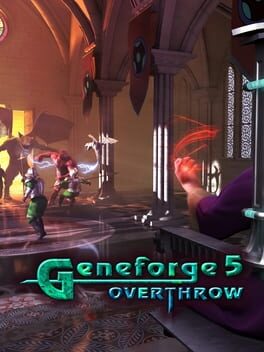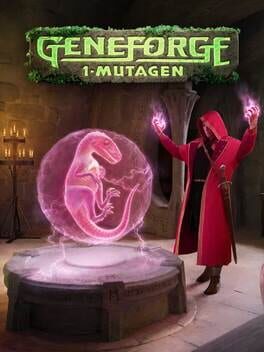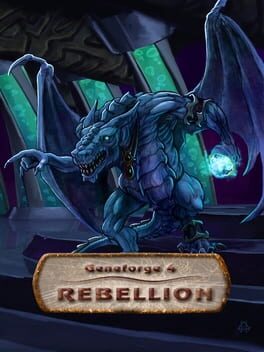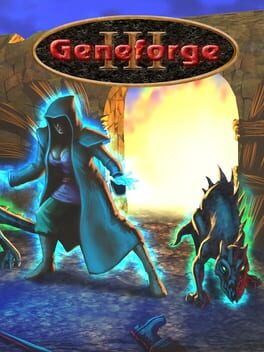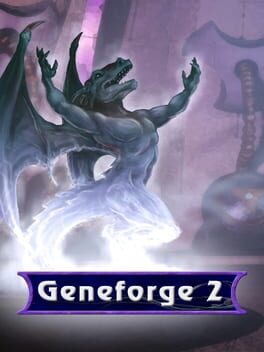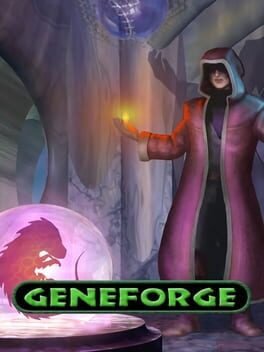

Geneforge 5: Overthrow is the fifth and final video game in the Geneforge series of role-playing video game created by Spiderweb Software.
Also in series
Reviews View More
This review contains spoilers
"And that is the tale of how the time of the Shapers came to an end and of how the people of Terrestia began to look for new ways to learn and advance. A journey from a small forgotten island to the farthest extent of the known lands."
When I played Geneforge 5, the final game in the series, the same question kept occuring to me over my 60 hour playtime. How do you end an rpg series like Geneforge? Each Geneforge game exists both as an narrative elaboration and enrichening of the universe long term players have invested in and as an entry point for new players. With Geneforge 5 this balance is made all the more precarious because of its finality. How do you provide a satisfying goodbye for a universe that by design encourages players to make their own diverging interpretations of it? There is no carried over save between Geneforge games and each entry has its own distinct factions, ideological conflict and endings so that by the time of 5, there are many different types of players who have created their own distinct expectations for 5, a game that somehow has to account for these without any crutches in the form of save transfers or increases in length or scope (it was made in the same amount of time as its predecessors and has roughly the same scope too).
Of course this same question is applicable towards a lot of other RPG series'. But I really only started thinking about it with Geneforge is because I have yet to play an rpg series with the same degree of thematic and mechanical consistency. It's serialization arguably has more in common with novels than video games. More times often than not I find video games to be ill suited as a medium for consistent and coherent long form storytelling. The nature of AAA software production in conjunction with the influence of capital, both of which reduce the craftperson's creative autonomy, can make game development a poor environment for the survival of multi-game stories. Most series' I have played tend to settle on a looser, standalone and overall safer approach to multi-game storytelling and in many cases their thematic potential is disrupted by material realities. To move away from the faux theorizing and speak more bluntly, this greatly hinders the capacity of most video game series' to reap the benefits of long form storytelling. I love fantasy as a genre and especially so in the form of big stupid epic fantasy series like say Malazan. Yeah, Malazan is sometimes sanctimonious, preachy and distasteful in certain scenes but as a complete and densely interconnected work, a passionate and sincere expression of someone who genuinely it would be his last chance to truly make something meaningful. I adore it. I could never see something like Malazan surviving a typical gaming publisher.
Naturally there is a big asterix to my above spiel in the form of Indies. Indie devs do not necessarily have to worry about publisher interference and consequently enjoy much more freedom in creating what they want to create. Vogel in particular had already been prolific in the shareware scene for a half a decade when the first Geneforge was released. He already released the Exile trilogy which over the course of three games portrayed a broad narrative of imprisonment and revolt. And though he never initially intended for Geneforge to be a series and each game is intended to be friendly to newcomers, there's a quiet yet thorough commitment to serialized world building. From 2 onwards each entry both deepens the setting while also wrinkling it so to question and complicate assumptions. People, groups and places naturally change and adapt both before and during a long and devastating war. So much time passes between 1 and 5 that people view the poorly documented events surrounding Sucia Island through a legendary lens that has contributed to the construction of new group identities. Indeed, one of the most revolutionary ideologies introduced in Geneforge 4 and iterated in Geneforge 5 has its real origins all the way back in the original game. In this regard, it achieves a real impression of depth as even the most novel movements and ideas have some textual origin. It's the sort of confident and thorough iteration that one would expect from someone who was able to work uninterrupted on a universe that was in all ways his own.
Geneforge 5 then is able to reap the benefits of such a rich and thoroughly developed setting. In that regard it is most rewarding for series veterans who can appreciate the final evolution of ideas played around with in earlier entries. Yet Vogel still threw new players a bone by framing the protagonist as an amnesiac. Such an archetype is deeply formulaic yet its usage in 5 serves to reinforce core themes of the setting while also providing a beginners insight into the complexities of the world. 5 smartly never makes the mystery of the protagonist's identity become central to the plot at risk of overshadowing the setting. Rather it serves as a natural guide towards the various factions making up the world so that the player's natural curiosity of their origins is gradually molded towards a more ideological interest in the various groups vying for hegemony. It ties in nicely with the conceit that the Player's amnesia is the result of extreme shaping. In the end whoever the protagonist was is overshadowed by the protagonist to be, the one whose actions will help decide the future of Terrestria.
Indeed, more than any prior entry since 1 at least 5 makes the setting in all its accumulated facets the center of the experience. It does so by synthesizing the sandbox structure and factional interplay of Geneforge 1 and 2 with Geneforge 3 and 4's emphasis on a more guided and slightly abstracted continental scope. To elaborate on that, each Geneforge gradually moves closer and closer to the Shaper heartlands and 5 brings this process to its conclusion being set in Western Terrestia where the ruling Shaper Council is located. Rather than heavily guide the player's journey as was done in 3 and 4, after leaving the White Spire Mountains, the player is free to engage with the various factions of Terrestia not withstanding some soft barriers. By this point in the series, the war has reached a point of near stalemate as both the Shapers and Rebels lack any decisive edge over the other. Consequently the failure of conventional warfare and tactics to resolve the conflict in addition to the radical dislocation and devastation of the war has shattered the political consensus and prompted Shaper and non-Shaper elites to seek alternate paths to peace. It's a rich, multifaceted setting that's only rivaled by Geneforge 1's Sucia Island. Like that game, 5 deeply humanizes all of Western Terrestia's inhabitants and parallels their experience with their historical forebearers. Before the arrival of the Shapers, the peoples of Western Terrestia made up many independent groups. The Shaper empire was built upon their conquest and assimilation into the Imperial project and popular memory of the pre-Shaper past interwine with the devastation of the Shaper War. In truth, this aspect of 5 could have been fleshed out as the agency of the region's political elites are favored over the fate of its ordinary inhabitants.
This focus on domestic politics interweaves seamlessly with the greater emphasis on factional conflict as the backbone of the game's structure. It navigates a fine line between giving the protagonist some agency in who they decide to align with while also preventing them from quickly rising through the ranks to become leader. Ultimately, Geneforge 5 makes the protagonist work for factions instead of them working for the protagonist and it is all the better for it. The various people you meet hold deeply rooted beliefs informed by their life experiences that are not uprooted just because of the Protagonist's charisma and likewise each faction and their collective tenets are never compromised in the face of the player. Geneforge 5 lets you be an agent and engage in genuinely interesting espionage and diplomacy but it sets a limit to how much the player alone can actually do. Its telling that the only way to get an unequivocally 'bad' ending is to lock yourself off of every factional storyline so that the one thing everyone agrees upon is that you are better off alive than dead. But that's fine because I love being an agent. The range of factions you can join widens in tandem with the range of locations you can access. First you're limited to being the lackey of Shaper Rawal in the Whitespires and then Agent Astoria of the Mera Tev and many more beyond that. You quickly find yourself caught between several factions at a time. Furthermore, several quests revolve around an item sought out by multiple interested parties and a definitive choice has to be made that impacts factional reputation. Even beyond those quests, nearly every opinion you express and quest you do gradually increases hidden formulas and moulds how other factions see you. That sounds rather banal given how common 'reputation' is in sandbox rpgs but there's a refreshing minimalism to it in 5. It's a more organic approach to choice and consequence that eschews arbitrarily filling up a meter and instead a more gradual and uneven self-fashioning that naturally opens up some doors whilst closing others.
The factional conflict comes into full bloom in the second half of 5 when you gain access to Southern Terrestia and thus all five factions. Unfortunately there is a slight lessening of quality after the halfway point that was not present in Geneforge 4. The first half of 5 is densely built and interconnected, the Whitespires, the Mera Tev and Okaveno Fens is densely interconnected in both geography and questlines so that you are always doing something meaningful that affects something else. There is still some of this in the Storm Plains and Dera Reaches but these regions are overall sparser and lacking in the careful attention to detail demonstrated earlier. At least the factions are as interesting here as in the Northern Terrestia. Whereas the somewhat more sheltered Mera Tev has allowed Astoria to parlay with the Rebels, the Storm Plains are the frontline of the Rebellion and its defender Alwan, returning from 3 and 4, has become more idea than person in his uncompromising and fanatical defence of traditional Shaper ideals while his colleague further south experiments with a plan that reveals Shaper politics at their most nakedly fascistic and genocidal. Though I wish there was just a bit more here in terms of density the second half of 5 shows how rich and multifaceted this fictional universe has become and the ease in which it facilitates the playstyles and ideological leanings of the many types of players this series has accumulated.
I was somewhat disheartened playing through 5 knowing that there would be no more Geneforge after it. Yet when I reached the credits I felt the same sort of satisfaction that I associate with a good series of books that comes naturally to a fitting conclusion. There could have been a Geneforge 6 but what purpose would it really serve? This series reinvigorated my love of rpgs after a long period of time where I thought I had outgrown them. There were ups and downs but across my hundreds of hours playing this series I never grew exhausted with it the same way I grew exhausted after only 30 hours of Starfield. Even though there will never be a new Geneforge there will be remakes and more significantly replays where I can enjoy these games in whole new lenses. And even then I'll be able to cherish the many wonderful memories I have made with this series. There's so much more I could talk about like all the effort that was put into playing as a Servile or the other stupid stuff I talked about in my logs. I barely even mentioned the gameplay (its quite unbalanced)! I guess I'll conclude this overstuff review with something sincere.
Thank you Jeff Vogel.
"The characters in this history are all gone now. But the results of their struggles, of the risks they took, the fears they overcame, and the decisions they tried to make wisely. the product of their labors continues to this day.
For us to understand, to endure, and, if needed, to change."
When I played Geneforge 5, the final game in the series, the same question kept occuring to me over my 60 hour playtime. How do you end an rpg series like Geneforge? Each Geneforge game exists both as an narrative elaboration and enrichening of the universe long term players have invested in and as an entry point for new players. With Geneforge 5 this balance is made all the more precarious because of its finality. How do you provide a satisfying goodbye for a universe that by design encourages players to make their own diverging interpretations of it? There is no carried over save between Geneforge games and each entry has its own distinct factions, ideological conflict and endings so that by the time of 5, there are many different types of players who have created their own distinct expectations for 5, a game that somehow has to account for these without any crutches in the form of save transfers or increases in length or scope (it was made in the same amount of time as its predecessors and has roughly the same scope too).
Of course this same question is applicable towards a lot of other RPG series'. But I really only started thinking about it with Geneforge is because I have yet to play an rpg series with the same degree of thematic and mechanical consistency. It's serialization arguably has more in common with novels than video games. More times often than not I find video games to be ill suited as a medium for consistent and coherent long form storytelling. The nature of AAA software production in conjunction with the influence of capital, both of which reduce the craftperson's creative autonomy, can make game development a poor environment for the survival of multi-game stories. Most series' I have played tend to settle on a looser, standalone and overall safer approach to multi-game storytelling and in many cases their thematic potential is disrupted by material realities. To move away from the faux theorizing and speak more bluntly, this greatly hinders the capacity of most video game series' to reap the benefits of long form storytelling. I love fantasy as a genre and especially so in the form of big stupid epic fantasy series like say Malazan. Yeah, Malazan is sometimes sanctimonious, preachy and distasteful in certain scenes but as a complete and densely interconnected work, a passionate and sincere expression of someone who genuinely it would be his last chance to truly make something meaningful. I adore it. I could never see something like Malazan surviving a typical gaming publisher.
Naturally there is a big asterix to my above spiel in the form of Indies. Indie devs do not necessarily have to worry about publisher interference and consequently enjoy much more freedom in creating what they want to create. Vogel in particular had already been prolific in the shareware scene for a half a decade when the first Geneforge was released. He already released the Exile trilogy which over the course of three games portrayed a broad narrative of imprisonment and revolt. And though he never initially intended for Geneforge to be a series and each game is intended to be friendly to newcomers, there's a quiet yet thorough commitment to serialized world building. From 2 onwards each entry both deepens the setting while also wrinkling it so to question and complicate assumptions. People, groups and places naturally change and adapt both before and during a long and devastating war. So much time passes between 1 and 5 that people view the poorly documented events surrounding Sucia Island through a legendary lens that has contributed to the construction of new group identities. Indeed, one of the most revolutionary ideologies introduced in Geneforge 4 and iterated in Geneforge 5 has its real origins all the way back in the original game. In this regard, it achieves a real impression of depth as even the most novel movements and ideas have some textual origin. It's the sort of confident and thorough iteration that one would expect from someone who was able to work uninterrupted on a universe that was in all ways his own.
Geneforge 5 then is able to reap the benefits of such a rich and thoroughly developed setting. In that regard it is most rewarding for series veterans who can appreciate the final evolution of ideas played around with in earlier entries. Yet Vogel still threw new players a bone by framing the protagonist as an amnesiac. Such an archetype is deeply formulaic yet its usage in 5 serves to reinforce core themes of the setting while also providing a beginners insight into the complexities of the world. 5 smartly never makes the mystery of the protagonist's identity become central to the plot at risk of overshadowing the setting. Rather it serves as a natural guide towards the various factions making up the world so that the player's natural curiosity of their origins is gradually molded towards a more ideological interest in the various groups vying for hegemony. It ties in nicely with the conceit that the Player's amnesia is the result of extreme shaping. In the end whoever the protagonist was is overshadowed by the protagonist to be, the one whose actions will help decide the future of Terrestria.
Indeed, more than any prior entry since 1 at least 5 makes the setting in all its accumulated facets the center of the experience. It does so by synthesizing the sandbox structure and factional interplay of Geneforge 1 and 2 with Geneforge 3 and 4's emphasis on a more guided and slightly abstracted continental scope. To elaborate on that, each Geneforge gradually moves closer and closer to the Shaper heartlands and 5 brings this process to its conclusion being set in Western Terrestia where the ruling Shaper Council is located. Rather than heavily guide the player's journey as was done in 3 and 4, after leaving the White Spire Mountains, the player is free to engage with the various factions of Terrestia not withstanding some soft barriers. By this point in the series, the war has reached a point of near stalemate as both the Shapers and Rebels lack any decisive edge over the other. Consequently the failure of conventional warfare and tactics to resolve the conflict in addition to the radical dislocation and devastation of the war has shattered the political consensus and prompted Shaper and non-Shaper elites to seek alternate paths to peace. It's a rich, multifaceted setting that's only rivaled by Geneforge 1's Sucia Island. Like that game, 5 deeply humanizes all of Western Terrestia's inhabitants and parallels their experience with their historical forebearers. Before the arrival of the Shapers, the peoples of Western Terrestia made up many independent groups. The Shaper empire was built upon their conquest and assimilation into the Imperial project and popular memory of the pre-Shaper past interwine with the devastation of the Shaper War. In truth, this aspect of 5 could have been fleshed out as the agency of the region's political elites are favored over the fate of its ordinary inhabitants.
This focus on domestic politics interweaves seamlessly with the greater emphasis on factional conflict as the backbone of the game's structure. It navigates a fine line between giving the protagonist some agency in who they decide to align with while also preventing them from quickly rising through the ranks to become leader. Ultimately, Geneforge 5 makes the protagonist work for factions instead of them working for the protagonist and it is all the better for it. The various people you meet hold deeply rooted beliefs informed by their life experiences that are not uprooted just because of the Protagonist's charisma and likewise each faction and their collective tenets are never compromised in the face of the player. Geneforge 5 lets you be an agent and engage in genuinely interesting espionage and diplomacy but it sets a limit to how much the player alone can actually do. Its telling that the only way to get an unequivocally 'bad' ending is to lock yourself off of every factional storyline so that the one thing everyone agrees upon is that you are better off alive than dead. But that's fine because I love being an agent. The range of factions you can join widens in tandem with the range of locations you can access. First you're limited to being the lackey of Shaper Rawal in the Whitespires and then Agent Astoria of the Mera Tev and many more beyond that. You quickly find yourself caught between several factions at a time. Furthermore, several quests revolve around an item sought out by multiple interested parties and a definitive choice has to be made that impacts factional reputation. Even beyond those quests, nearly every opinion you express and quest you do gradually increases hidden formulas and moulds how other factions see you. That sounds rather banal given how common 'reputation' is in sandbox rpgs but there's a refreshing minimalism to it in 5. It's a more organic approach to choice and consequence that eschews arbitrarily filling up a meter and instead a more gradual and uneven self-fashioning that naturally opens up some doors whilst closing others.
The factional conflict comes into full bloom in the second half of 5 when you gain access to Southern Terrestia and thus all five factions. Unfortunately there is a slight lessening of quality after the halfway point that was not present in Geneforge 4. The first half of 5 is densely built and interconnected, the Whitespires, the Mera Tev and Okaveno Fens is densely interconnected in both geography and questlines so that you are always doing something meaningful that affects something else. There is still some of this in the Storm Plains and Dera Reaches but these regions are overall sparser and lacking in the careful attention to detail demonstrated earlier. At least the factions are as interesting here as in the Northern Terrestia. Whereas the somewhat more sheltered Mera Tev has allowed Astoria to parlay with the Rebels, the Storm Plains are the frontline of the Rebellion and its defender Alwan, returning from 3 and 4, has become more idea than person in his uncompromising and fanatical defence of traditional Shaper ideals while his colleague further south experiments with a plan that reveals Shaper politics at their most nakedly fascistic and genocidal. Though I wish there was just a bit more here in terms of density the second half of 5 shows how rich and multifaceted this fictional universe has become and the ease in which it facilitates the playstyles and ideological leanings of the many types of players this series has accumulated.
I was somewhat disheartened playing through 5 knowing that there would be no more Geneforge after it. Yet when I reached the credits I felt the same sort of satisfaction that I associate with a good series of books that comes naturally to a fitting conclusion. There could have been a Geneforge 6 but what purpose would it really serve? This series reinvigorated my love of rpgs after a long period of time where I thought I had outgrown them. There were ups and downs but across my hundreds of hours playing this series I never grew exhausted with it the same way I grew exhausted after only 30 hours of Starfield. Even though there will never be a new Geneforge there will be remakes and more significantly replays where I can enjoy these games in whole new lenses. And even then I'll be able to cherish the many wonderful memories I have made with this series. There's so much more I could talk about like all the effort that was put into playing as a Servile or the other stupid stuff I talked about in my logs. I barely even mentioned the gameplay (its quite unbalanced)! I guess I'll conclude this overstuff review with something sincere.
Thank you Jeff Vogel.
"The characters in this history are all gone now. But the results of their struggles, of the risks they took, the fears they overcame, and the decisions they tried to make wisely. the product of their labors continues to this day.
For us to understand, to endure, and, if needed, to change."
